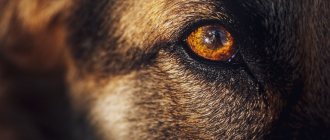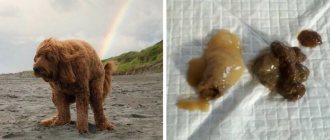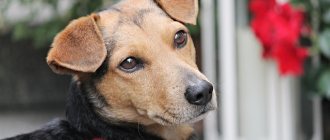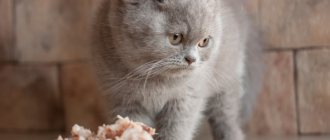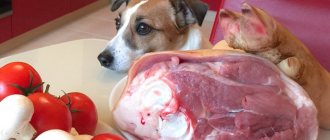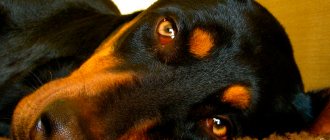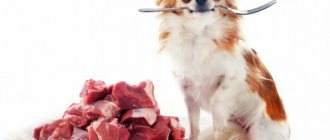An attentive owner always monitors the regular discharge of all natural needs by his pet.
Any failure or presence of any inclusions in the stool causes concern to the dog owner.
What are the reasons for the presence of mucus in feces, what actions should the owner take, we will consider further.
Reasons for the presence of mucus in stool
The presence of mucus in the feces indicates the course of pathological processes in the dog’s body, primarily inflammatory ones.
The causes of the formation and release of mucus are diseases such as:
- colitis or inflammation of the large intestine;
- dysbacteriosis, which develops due to changes in the composition of the microflora of the gastrointestinal tract;
- helminthiasis is an infection by worms of both the digestive tract and any other organ of the dog;
- gastritis or inflammation of the gastric mucosa;
- gastroenteritis or inflammation of the stomach and small intestine;
- stomach ulcer.
All these dangerous diseases of the gastrointestinal tract develop due to:
- stressful situations that a pet experiences, for example, when the owner treats it roughly;
- using antibiotics without a doctor's prescription;
- lack of a diet that includes easily digestible food, vitamin and mineral supplements;
- the use of dangerous food from the “master’s” table, which has a spicy or sweet taste that is contraindicated for animals;
- lack of regular vaccination and antiparasitic treatment.
If you postpone a visit to the clinic for timely medical care, the clinical picture may worsen: the pet refuses to eat, weight loss occurs, the animal is in a depressed state, the pet moves less, body temperature changes abruptly, and frequent stools with mucus are noted.
What to do if your dog has mucus in his stool
So, we found out what are the main reasons for the appearance of mucus in the feces of an animal. Now it’s time to clarify what treatment is required in each of the cases that lead to the appearance of a large amount of mucus in the stool:
- For bacterial colitis,
animals are usually given antibiotics, antispasmodics and anti-inflammatory drugs. The dog is prescribed a therapeutic diet with special food; - Enterocolitis is treated
with antibiotics, antispasmodics, enzyme preparations and adsorbents. In the first days of treatment, dogs are prescribed a diet with special food, or rice broth with boiled chicken; - Gastritis is treated
with antibiotics, antacids, antiemetics and proton pump inhibitors, and antispasmodics. Plus, the animal is prescribed a diet (special food in frequent and small portions, or rice with meat in the same dosages); - If a dog has gastroenteritis
, then, as a rule, the administration of antimicrobial drugs, adsorbents, analgesics and antispasmodics is required. The animal is prescribed a gentle diet; - When mucus in the stool is caused by a stomach ulcer
, surgery is required to remove the ulcer. Also, a sick dog may require antibiotics, antispasmodics and painkillers, anti-inflammatory, antiemetic and enveloping agents, drugs that suppress the production of hydrochloric acid, antacids; - If the dog has worms
, then you cannot do without the use of deworming drugs (Profender, Milbemax, Drontal, Kanikvantel, Dirofen, Prasitel, Cestal, etc.).
The copious amount of mucus contained in the stool whenever the dog relieves itself is considered a dangerous symptom of many digestive ailments. An owner who notices mucus in their pet’s feces should contact a veterinary clinic as soon as possible, where a specialist will determine what ailment has affected the animal and then prescribe the correct treatment. The presence of mucus in your pet's feces should not be ignored.
Diagnostics in a veterinary clinic
If you find mucus in your animal's stool, you should visit a veterinary clinic as soon as possible. This condition will not go away on its own, and the symptom serves as a signal to the animal owner about the development of pathology in the pet.
When visiting the clinic, the doctor conducts a visual examination of the dog, palpates the abdominal cavity and prescribes mandatory examinations, depending on the results of the examination of the animal:
- blood, urine, stool analysis;
- X-ray of the intestines;
- colonoscopy of the colon with a biopsy of the affected tissue;
- Ultrasound of the abdominal organs;
- gastric juice test to determine acidity (if necessary).
To determine an accurate diagnosis, doctors usually carry out a full range of diagnostics.
Based on the diagnostic results, the dog is prescribed a course of treatment.
The course of treatment may include both antimicrobial drugs and antibiotics, the use of which is decided by the doctor.
Binge eating
Many dogs are gluttons . You shouldn’t blame them for this, since in nature wolves, who are the ancestors of modern dogs, don’t get to eat every day. Considering that domestic dogs receive food in the proper quantity, they can overeat almost every day, “sweeping away” their food allowance in a few seconds.
As a result, food in the form of large pieces ends up in the stomach and intestines, making it difficult for the digestive system to process it. It “stagnates”, and putrefactive processes develop in the thickness of the food masses. The body responds accordingly to the appearance of a “hotbed” of toxins, and diarrhea begins.
Mucus impurities are just a protective reaction of the body plus an inflammatory process of the catarrhal type . If the cause of the development of pathology is indeed gluttony, it is necessary to put the pet on a daily starvation diet. During this time, the animal’s intestines will be cleared of unnecessary and toxic substances, and mucous diarrhea will subside on its own.
We immediately warn you: if the animal’s condition does not improve in any way within 24 hours, but signs of a deterioration in the process are clearly visible, immediately contact a veterinarian! Further waiting will not lead to anything good.
When to see a veterinarian
Active production of mucous secretion by the intestinal glands does not always indicate pathology. Sometimes the reason for bowel dysfunction is very simple. If it is associated with errors in nutrition or improper care of the animal, then you do not need to consult a doctor. The stool will recover on its own as soon as the correct feeding and care regimen is introduced.
Sometimes, observing the dog’s behavior helps to understand how serious the cause of feces with mucus is. If the animal feels well, is active and cheerful, then there is no reason to worry.
And if episodes of mucous diarrhea are repeated frequently, the pet is lethargic, does not eat anything, and refuses to walk, then this should alert you.
In this case, you cannot hesitate, since severe diarrhea quickly causes dehydration, and then death. The risk of such complications is especially high in puppies and older dogs.
Liver diseases
With liver disease, stool becomes not mucous, but “greasy.” Moreover, in the literal sense of the word. Since the liver either stops producing bile, or its entry into the intestinal lumen is for some reason difficult, the breakdown and absorption of lipids stops. This causes the feces to become slimy and very sticky. If your dog is a “pocket” breed, this is very easy to notice when you wash his litter box every day.
Contrary to popular belief, with “liver” pathologies, yellow stool does not happen!
Diarrhea in a puppy: the main thing
- Diarrhea in puppies is quite common and often goes away on its own without treatment.
- Prolonged diarrhea or complicated by vomiting, refusal to eat, lethargy, or bleeding is extremely dangerous for small puppies.
- Treatment will depend on the cause of the diarrhea.
- Timely treatments, vaccination and proper feeding are the best ways to prevent diarrhea.
General symptoms
Liquid stool (diarrhea) is not considered a dangerous condition if it lasts no more than 3-5 days. However, the dog owner should take a close look at his pet's stool. The feces of your four-legged friend may contain mucus, undigested food particles, and blood. It is very important to monitor the color of the stool, because an unnatural shade of feces indicates the presence of certain disorders:
- pale stool is a sign of liver pathologies,
- black color of feces - the dog has internal bleeding,
- green tint of excrement - possible presence of infectious diseases, food poisoning,
- Blood in a Yorkie's stool is a sign of dangerous infectious diseases, injuries, helminthiasis, and volvulus.
Attention! Diarrhea can be caused by feeding your pet low-quality and cheap food, a sudden transition from natural food to a dry diet, allergic reactions, or a side effect after treatment with antibiotics.
Diarrhea in a Yorkie can be a manifestation of various diseases and conditions. Each pathology is accompanied by its own characteristic symptoms. However, there are common signs of diarrhea in this breed of dog:
- frequent and loose stools;
- the presence of mucous impurities in feces;
- refusal to eat;
- extreme thirst due to dehydration;
- vomit;
- lethargy, apathy;
- chills;
- weight loss
Diagnosis and treatment
Mucus in the stool can indicate the presence of a number of diseases. Therefore, a dog with this disorder requires comprehensive diagnosis and treatment.
Progress of diagnostic measures
It is mandatory to conduct an external examination of the dog and interview the owner about the conditions of feeding and care.
A stool analysis provides a lot of information. With its help, the presence or absence of helminths in the intestines, the content of latent blood in the stool is revealed, and the inflammatory process is diagnosed. If colon tumors are suspected, a colonoscopy or MRI using a contrast agent is performed.
Before making a diagnosis, the doctor analyzes the clinical picture. In this case, the entire complex of symptoms is considered. Their combination, the predominance of some over others, and the brightness of their manifestation are taken into account:
- Inflammatory bowel diseases are characterized by an acute course, watery stools, and rapid onset of general symptoms.
- Anal fissures are always accompanied by severe pain. Defecation occurs with the release of a small amount of scarlet blood.
- Colitis of autoimmune etiology is usually characterized by strong urge in the absence of stool. During the urge, mucus of a characteristic greenish hue is released.
- In cases of pathology of the body's enzymatic system, feces usually contain remnants of undigested food.
- Helminth infections are characterized by severe itching of the anus, pain in the abdominal area, nausea, and abdominal enlargement.
Treatment
Treatment tactics differ in each case. The veterinarian-gastroenterologist, based on the results of the diagnostics, selects a regimen. Then the doctor makes appointments, monitors the treatment process, and, if necessary, makes adjustments.
- Food allergies are treated by strict adherence to a diet and the use of antihistamines. The allergen, the food or product that caused the allergic reaction, is excluded from the diet. Read more about dog food allergies.
- In case of dysbacteriosis, treatment should be comprehensive. To remove toxins and pathogenic microflora, sorbents are prescribed and infusion therapy is carried out. Then probiotics and prebiotics are prescribed to populate the intestines with beneficial microflora. Immunomodulator drugs are prescribed to maintain the body's defenses.
- For colitis, therapeutic fasting is recommended. Upon completion (after 2 days), improvement occurs (normal stool is restored). Then a therapeutic diet is developed for the dog. Fatty and carbohydrate foods are excluded. Medicines prescribed include drugs that eliminate diarrhea (Loperamide) and antimicrobial agents (Metronidazole). To restore water and electrolyte balance, droppers with potassium chloride are prescribed.
- Helminthiasis is treated by prescribing anthelmintic drugs. The dog is given special medications in a dosage appropriate to its age and size. After deworming, it is necessary to remove dead helminths from the body as soon as possible to eliminate the possibility of poisoning. To do this, it is recommended to give the dog a laxative or give an enema.
- When selecting a treatment regimen for gastroenteritis, attention is paid to its nature. Viral intestinal infections are treated with antiviral drugs. If the cause of the disease is poisoning of the body, then gastric lavage is done and antidotes are used. If gastroenteritis is a reaction to the use of potent drugs, then they are discontinued. If it is impossible to do this, reduce the dosage and prescribe gastroprotectors.
To stop severe diarrhea with blood and mucus, strengthening drugs are prescribed and the body is dehydrated.
How to feed a dog with diarrhea
Loose stools for one or two days are not a sign of a serious illness. Acute diarrhea lasts about two weeks and causes a serious blow to the entire body of the pet. In this case, the owner must provide his pet with a special diet.
Day one: the dog can only be given water. Under no circumstances should you give your pet food, even in small quantities. The body must recover well from diarrhea and loss of large amounts of microelements. Water contains potassium and sodium, which will help you recover and get rid of dehydration.
Day two: you can feed your pet a little. Do not immediately start giving the usual diet in large quantities, because on a weak stomach this can lead to a new wave of diarrhea. Also, do not give food from the common table in order to pity or appease the dog, this will only cause more harm. On the second day, the dog can be given chicken puree and yogurt to restore microflora. Food on this day is given in small portions.
Day three: on this day you can dilute your diet with a small amount of vegetables, because this is the main source of fiber. Remember also that you should not give vegetables that have a laxative effect. It is worth continuing to adhere to the principle of small amounts of food.
Day four: on this day you can add rice to your diet. On the fifth day, you should still stick to the diet, and on the sixth, start returning your pet to its usual balanced diet. Remember that large amounts of food can trigger recurrent diarrhea - give your usual food in small portions and often to relieve the intestines and stomach.
If the improvement in the animal’s condition is already noticeable, and the diarrhea has stopped, then you can increase the portions and gradually switch to the usual diet. Remember that your incorrect attitude to nutrition, overfeeding or food from the common table may have caused prolonged diarrhea.
Throughout the diet, you should carefully monitor the dog’s condition, monitor the quantity and quality of stool and the general condition of the body. In the first days, for the purpose of intoxication, you can and should give activated carbon diluted in water. The number of charcoal tablets depends on the dog's body weight. If your pet does not want to drink water with charcoal, then you can pour it through a syringe without a needle on the side of the mouth.
Remember that charcoal can only be given for the first three days; further use will lead to leaching from the body of beneficial microelements necessary to restore the effects of diarrhea.
First aid
If diarrhea is caused by temporary eating disorders or overeating, then the dog’s condition will normalize on its own after changing the diet. In this case, intestinal disorders last no more than a day, and then gradually disappear.
You should immediately contact your veterinarian if the following symptoms occur:
- diarrhea lasting more than 24 hours;
- fever;
- uncontrollable vomiting;
- severe weakness;
- causeless weight loss.
How to provide first aid for diarrhea in a Yorkie? What should you do if your animal suddenly develops diarrhea and feels worse? At the pre-medical stage, it is necessary to stop giving the dog food. Before contacting a veterinarian, a sick pet can only be given clean water to drink to prevent dehydration.
What to give your Yorkie for diarrhea? In such cases, you should not self-medicate. At the pre-medical stage, you can give your dog only enterosorbents: “Activated carbon”, “Smecta”, “Polysorb”, “Enterosgel”. These drugs will cleanse the animal's stomach of toxins. All other types of medications can only be prescribed by a specialist. Therefore, it is necessary to seek veterinary help as soon as possible.
Diarrhea and its main symptoms
Dog diarrhea, or diarrhea, is the repeated emptying of liquid feces due to problems with the digestive system.
Every owner faces this problem at least once. Sometimes a dog’s diarrhea ends quickly, and sometimes it lasts for several days or even weeks, causing a lot of inconvenience to the pet and its owner.
If the attack of diarrhea was a one-time occurrence, there is no particular cause for concern, but prolonged loose stools are considered a reason to consult a veterinarian. The level of danger increases the appearance of blood, mucous masses in the stool, as well as the lethargy of the pet. Diarrhea is often accompanied by vomiting and fever.
The causes of diarrhea in dogs can often be determined by the color of the stool. Treatment is symptomatic and takes place mainly at home. To prevent dehydration of the body, plenty of fluids and adsorbent drugs are prescribed. In serious cases, antibiotics are used - they are prescribed by a veterinarian.
Diarrhea and vomiting
If the dog has only loose and frequent stools, but there is no fever or vomiting, then the cause of diarrhea is most often:
- binge eating;
- mild intoxication with low-quality food;
- abrupt introduction of new food to the menu;
- food allergies;
- side effects of drugs.
In this case, it is necessary to reconsider the animal’s diet. Usually, when the diet is normalized, diarrhea disappears. If your dog is taking any medications, you should contact your veterinarian to adjust the treatment regimen.
Very often, diarrhea in Yorkshire Terriers is accompanied by vomiting. This is also usually associated with eating disorders. The body thus strives to get rid of excess food or poor quality food.
In some cases, these symptoms may be caused by inhaling fumes from toxic chemicals. In this case, the dog experiences a sharp deterioration in health and lacrimation. Foam vomiting is usually observed when foreign bodies enter the stomach.
Diarrhea with vomiting is also a sign of worm infection. Parasites can also leave the body during deworming.
Stool color
It is important to pay attention to the color of the feces. Unusual coloring of stool may be a sign of serious pathologies:
- Black feces This color of stool is a formidable sign. Tarry stool is a symptom of bleeding from the stomach or upper intestines due to ulcerative pathologies.
- The stool is white. Discolored stool is released when the bile ducts are blocked. This is accompanied by serious dysfunction of the gastrointestinal tract. Pieces of undigested food can be found in feces.
- Green feces The stool acquires this color in cases of severe poisoning with rotten food. This is a rather dangerous sign that indicates severe intoxication. Typically, the discharge of green feces is always accompanied by severe repeated vomiting.
Prevention
Stool with mucus in dogs may indicate the onset of a serious disease of the digestive system. To reduce the risk of intestinal pathologies, carry out constant prevention.
The main rule is careful control of the dog’s diet.
Food must be of high quality and fresh. It is advisable to choose premium food with a minimum content of artificial additives. If the feeding is natural, then the diet must be carefully balanced.
In addition, it is useful to strengthen the animal’s body. Walking in the fresh air and outdoor games will help. It is important to do regular deworming. It is recommended to bring your dog to the clinic for preventive examinations twice a year. When the first painful symptoms appear, do not hesitate. Early contact with a veterinarian, thorough diagnosis and timely treatment are the key to stopping the disease at an early stage and allowing your four-legged friend to be active and cheerful again.
